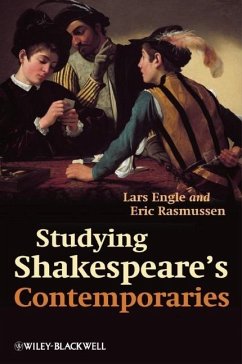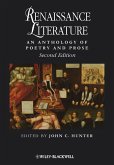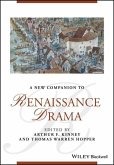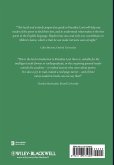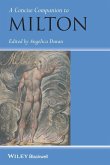26,99 €
inkl. MwSt.
Versandfertig in über 4 Wochen

13 °P sammeln
- Broschiertes Buch
- Merkliste
- Auf die Merkliste
- Bewerten Bewerten
- Teilen
- Produkt teilen
- Produkterinnerung
- Produkterinnerung
Studying Shakespeare's Contemporaries is an accessible guide to non-Shakespearian English drama of the late 16th and early 17th centuries. Featuring works of prestigious playwrights such as Kyd, Marlowe, Jonson, Webster, and Middleton, Lars Engle describes the conditions under which Renaissance plays were commissioned, written, licensed, staged, and published. Plays are organized by theme and explored individually, creating a text that can be read as a complete overview of English Renaissance drama or used as an indexed reference resource.
Andere Kunden interessierten sich auch für
![Renaissance Literature Renaissance Literature]() John HunterRenaissance Literature49,99 €
John HunterRenaissance Literature49,99 €![A Concise Companion to the Study of Manuscripts, Printed Books, and the Production of Early Modern Texts A Concise Companion to the Study of Manuscripts, Printed Books, and the Production of Early Modern Texts]() A Concise Companion to the Study of Manuscripts, Printed Books, and the Production of Early Modern Texts116,99 €
A Concise Companion to the Study of Manuscripts, Printed Books, and the Production of Early Modern Texts116,99 €![A Companion to the Global Renaissance A Companion to the Global Renaissance]() A Companion to the Global Renaissance201,99 €
A Companion to the Global Renaissance201,99 €![A New Companion to Renaissance Drama A New Companion to Renaissance Drama]() A New Companion to Renaissance Drama216,99 €
A New Companion to Renaissance Drama216,99 €![Reading Paradise Lost Reading Paradise Lost]() David HopkinsReading Paradise Lost54,99 €
David HopkinsReading Paradise Lost54,99 €![A Concise Companion to Milton A Concise Companion to Milton]() A Concise Companion to Milton46,99 €
A Concise Companion to Milton46,99 €![1611 1611]() Helen Wilcox161194,99 €
Helen Wilcox161194,99 €-
-
-
Studying Shakespeare's Contemporaries is an accessible guide to non-Shakespearian English drama of the late 16th and early 17th centuries. Featuring works of prestigious playwrights such as Kyd, Marlowe, Jonson, Webster, and Middleton, Lars Engle describes the conditions under which Renaissance plays were commissioned, written, licensed, staged, and published. Plays are organized by theme and explored individually, creating a text that can be read as a complete overview of English Renaissance drama or used as an indexed reference resource.
Hinweis: Dieser Artikel kann nur an eine deutsche Lieferadresse ausgeliefert werden.
Hinweis: Dieser Artikel kann nur an eine deutsche Lieferadresse ausgeliefert werden.
Produktdetails
- Produktdetails
- Verlag: Wiley & Sons / Wiley-Blackwell
- 1. Auflage
- Seitenzahl: 272
- Erscheinungstermin: 3. Februar 2014
- Englisch
- Abmessung: 226mm x 152mm x 18mm
- Gewicht: 340g
- ISBN-13: 9781405132442
- ISBN-10: 1405132442
- Artikelnr.: 39366575
- Herstellerkennzeichnung
- Libri GmbH
- Europaallee 1
- 36244 Bad Hersfeld
- gpsr@libri.de
- Verlag: Wiley & Sons / Wiley-Blackwell
- 1. Auflage
- Seitenzahl: 272
- Erscheinungstermin: 3. Februar 2014
- Englisch
- Abmessung: 226mm x 152mm x 18mm
- Gewicht: 340g
- ISBN-13: 9781405132442
- ISBN-10: 1405132442
- Artikelnr.: 39366575
- Herstellerkennzeichnung
- Libri GmbH
- Europaallee 1
- 36244 Bad Hersfeld
- gpsr@libri.de
Lars Engle chairs the English Department at The University of Tulsa, USA, where he has won college and university teaching awards. Educated at Harvard, Cambridge, and Yale, he is the author of Shakespearean Pragmatism (1993) and numerous articles on Shakespeare and Renaissance drama. He was one of the editors of English Renaissance Drama: A Norton Anthology (2002), and a former Trustee of the Shakespeare Association of America. Eric Rasmussen is Chair and Professor of English at the University of Nevada. He is co-editor of a variety of publications, including the English Renaissance Drama: A Norton Anthology (2002), the Royal Shakespeare Company's Complete Works of William Shakespeare (2008), and The Shakespeare First Folios: A Descriptive Catalogue (2011).He is also the General Textual Editor of the Internet Shakespeare Editions project.
Acknowledgments ix
Preface: How to use this book xi
Part One: Inwardness 1
1.1 The Inward Self 2
1.2 The Inward Self in Soliloquy: The Jew of Malta 4
1.3 The Inward Self in Aside: The Changeling 16
1.4 A Digression: The Inner Life of Modernized Texts 25
1.5 The Christian/Stoic Soul Under Duress: The Duchess of Malfi 36
1.6 How to Behave When You Have a Soul Always Already Damned: Doctor
Faustus 42
1.7 Obsession and Delusion: Comic Inwardness in Every Man in His Humor 53
1.8 Epicene 63
1.9 Tamburlaine the Great 1 and 2: Interior Strength, External Weakness 68
1.10 Disguise and Honor in The Malcontent 78
1.11 Conclusion: A Drama of Interiority? 80
Part Two: Intimacy, Rivalry, Family 83
2.1 Rivalry and Intimacy in A Trick to Catch the Old One 85
2.2 The Tragedy of Mariam: Intimacy, Tyranny, and Ambivalence 90
2.3 Domestic Tragedy and Moral Commentary: Arden of Faversham 96
2.4 The Battle of the Sexes: The Woman's Prize 99
2.5 Intimacy, Rivalry, Family: Women Beware Women 103
2.6 Familiar and Familial: Incest in 'Tis Pity She's a Whore 113
Part Three: Society, Politics, the City, and the State 123
3.1 Dreaming Up the Free City: The Roaring Girl 124
3.2 The Shoemaker's Holiday 138
3.3 A New Way to Pay Old Debts 144
3.4 The Knight of the Burning Pestle 155
3.5 The State at War in The Spanish Tragedy 161
3.6 Two Bodies: State and Self in Edward II 167
3.7 Resistance to Tyranny in The Maid's Tragedy 173
3.8 Tyranny as a Boundary Condition for a Subject's Violence: The Duchess
of Malfi and The Revenger's Tragedy 189
3.9 Republic and Tyranny in Sejanus 190
Part Four: Not Shakespeare - Lives of the Theater Poets 207
4.1 "Non-Shakespearean": The Dire Privative 207
4.2 Christopher Marlowe 209
4.3 Ben Jonson 211
4.4 Thomas Middleton 215
4.5 Thomas Kyd 217
4.6 Thomas Dekker 218
4.7 Francis Beaumont 218
4.8 John Fletcher 219
4.9 John Ford 220
4.10 John Marston 221
4.11 Philip Massinger 221
4.12 Elizabeth Cary 222
Appendix: Performance History 225
Bibliography 245
Index 251
Preface: How to use this book xi
Part One: Inwardness 1
1.1 The Inward Self 2
1.2 The Inward Self in Soliloquy: The Jew of Malta 4
1.3 The Inward Self in Aside: The Changeling 16
1.4 A Digression: The Inner Life of Modernized Texts 25
1.5 The Christian/Stoic Soul Under Duress: The Duchess of Malfi 36
1.6 How to Behave When You Have a Soul Always Already Damned: Doctor
Faustus 42
1.7 Obsession and Delusion: Comic Inwardness in Every Man in His Humor 53
1.8 Epicene 63
1.9 Tamburlaine the Great 1 and 2: Interior Strength, External Weakness 68
1.10 Disguise and Honor in The Malcontent 78
1.11 Conclusion: A Drama of Interiority? 80
Part Two: Intimacy, Rivalry, Family 83
2.1 Rivalry and Intimacy in A Trick to Catch the Old One 85
2.2 The Tragedy of Mariam: Intimacy, Tyranny, and Ambivalence 90
2.3 Domestic Tragedy and Moral Commentary: Arden of Faversham 96
2.4 The Battle of the Sexes: The Woman's Prize 99
2.5 Intimacy, Rivalry, Family: Women Beware Women 103
2.6 Familiar and Familial: Incest in 'Tis Pity She's a Whore 113
Part Three: Society, Politics, the City, and the State 123
3.1 Dreaming Up the Free City: The Roaring Girl 124
3.2 The Shoemaker's Holiday 138
3.3 A New Way to Pay Old Debts 144
3.4 The Knight of the Burning Pestle 155
3.5 The State at War in The Spanish Tragedy 161
3.6 Two Bodies: State and Self in Edward II 167
3.7 Resistance to Tyranny in The Maid's Tragedy 173
3.8 Tyranny as a Boundary Condition for a Subject's Violence: The Duchess
of Malfi and The Revenger's Tragedy 189
3.9 Republic and Tyranny in Sejanus 190
Part Four: Not Shakespeare - Lives of the Theater Poets 207
4.1 "Non-Shakespearean": The Dire Privative 207
4.2 Christopher Marlowe 209
4.3 Ben Jonson 211
4.4 Thomas Middleton 215
4.5 Thomas Kyd 217
4.6 Thomas Dekker 218
4.7 Francis Beaumont 218
4.8 John Fletcher 219
4.9 John Ford 220
4.10 John Marston 221
4.11 Philip Massinger 221
4.12 Elizabeth Cary 222
Appendix: Performance History 225
Bibliography 245
Index 251
Acknowledgments ix
Preface: How to use this book xi
Part One: Inwardness 1
1.1 The Inward Self 2
1.2 The Inward Self in Soliloquy: The Jew of Malta 4
1.3 The Inward Self in Aside: The Changeling 16
1.4 A Digression: The Inner Life of Modernized Texts 25
1.5 The Christian/Stoic Soul Under Duress: The Duchess of Malfi 36
1.6 How to Behave When You Have a Soul Always Already Damned: Doctor
Faustus 42
1.7 Obsession and Delusion: Comic Inwardness in Every Man in His Humor 53
1.8 Epicene 63
1.9 Tamburlaine the Great 1 and 2: Interior Strength, External Weakness 68
1.10 Disguise and Honor in The Malcontent 78
1.11 Conclusion: A Drama of Interiority? 80
Part Two: Intimacy, Rivalry, Family 83
2.1 Rivalry and Intimacy in A Trick to Catch the Old One 85
2.2 The Tragedy of Mariam: Intimacy, Tyranny, and Ambivalence 90
2.3 Domestic Tragedy and Moral Commentary: Arden of Faversham 96
2.4 The Battle of the Sexes: The Woman's Prize 99
2.5 Intimacy, Rivalry, Family: Women Beware Women 103
2.6 Familiar and Familial: Incest in 'Tis Pity She's a Whore 113
Part Three: Society, Politics, the City, and the State 123
3.1 Dreaming Up the Free City: The Roaring Girl 124
3.2 The Shoemaker's Holiday 138
3.3 A New Way to Pay Old Debts 144
3.4 The Knight of the Burning Pestle 155
3.5 The State at War in The Spanish Tragedy 161
3.6 Two Bodies: State and Self in Edward II 167
3.7 Resistance to Tyranny in The Maid's Tragedy 173
3.8 Tyranny as a Boundary Condition for a Subject's Violence: The Duchess
of Malfi and The Revenger's Tragedy 189
3.9 Republic and Tyranny in Sejanus 190
Part Four: Not Shakespeare - Lives of the Theater Poets 207
4.1 "Non-Shakespearean": The Dire Privative 207
4.2 Christopher Marlowe 209
4.3 Ben Jonson 211
4.4 Thomas Middleton 215
4.5 Thomas Kyd 217
4.6 Thomas Dekker 218
4.7 Francis Beaumont 218
4.8 John Fletcher 219
4.9 John Ford 220
4.10 John Marston 221
4.11 Philip Massinger 221
4.12 Elizabeth Cary 222
Appendix: Performance History 225
Bibliography 245
Index 251
Preface: How to use this book xi
Part One: Inwardness 1
1.1 The Inward Self 2
1.2 The Inward Self in Soliloquy: The Jew of Malta 4
1.3 The Inward Self in Aside: The Changeling 16
1.4 A Digression: The Inner Life of Modernized Texts 25
1.5 The Christian/Stoic Soul Under Duress: The Duchess of Malfi 36
1.6 How to Behave When You Have a Soul Always Already Damned: Doctor
Faustus 42
1.7 Obsession and Delusion: Comic Inwardness in Every Man in His Humor 53
1.8 Epicene 63
1.9 Tamburlaine the Great 1 and 2: Interior Strength, External Weakness 68
1.10 Disguise and Honor in The Malcontent 78
1.11 Conclusion: A Drama of Interiority? 80
Part Two: Intimacy, Rivalry, Family 83
2.1 Rivalry and Intimacy in A Trick to Catch the Old One 85
2.2 The Tragedy of Mariam: Intimacy, Tyranny, and Ambivalence 90
2.3 Domestic Tragedy and Moral Commentary: Arden of Faversham 96
2.4 The Battle of the Sexes: The Woman's Prize 99
2.5 Intimacy, Rivalry, Family: Women Beware Women 103
2.6 Familiar and Familial: Incest in 'Tis Pity She's a Whore 113
Part Three: Society, Politics, the City, and the State 123
3.1 Dreaming Up the Free City: The Roaring Girl 124
3.2 The Shoemaker's Holiday 138
3.3 A New Way to Pay Old Debts 144
3.4 The Knight of the Burning Pestle 155
3.5 The State at War in The Spanish Tragedy 161
3.6 Two Bodies: State and Self in Edward II 167
3.7 Resistance to Tyranny in The Maid's Tragedy 173
3.8 Tyranny as a Boundary Condition for a Subject's Violence: The Duchess
of Malfi and The Revenger's Tragedy 189
3.9 Republic and Tyranny in Sejanus 190
Part Four: Not Shakespeare - Lives of the Theater Poets 207
4.1 "Non-Shakespearean": The Dire Privative 207
4.2 Christopher Marlowe 209
4.3 Ben Jonson 211
4.4 Thomas Middleton 215
4.5 Thomas Kyd 217
4.6 Thomas Dekker 218
4.7 Francis Beaumont 218
4.8 John Fletcher 219
4.9 John Ford 220
4.10 John Marston 221
4.11 Philip Massinger 221
4.12 Elizabeth Cary 222
Appendix: Performance History 225
Bibliography 245
Index 251
